- Author: Cheryl Reynolds
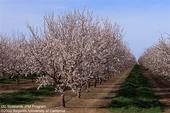
‘Tis the season for baking lots of tasty treats. Breads, cookies, cakes, and candy are just a few that come to mind. What makes many of these treats so tasty is the addition of almonds or walnuts to the list of ingredients.
In California, we are lucky to be at the center of almond and walnut production. According to the California Department of Food and Agriculture's (CDFA's) latest Agricultural Statistics Review, more than 99 percent of the almonds and walnuts produced in the United States are grown in California.
Almond and walnut growers work tirelessly to supply enough nuts to not only satisfy domestic demand, but also for export. Worldwide,...
- Author: Jeannette E. Warnert
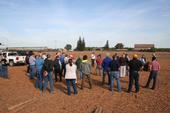
The numbers are beginning to trickle in confirming UC Cooperative Extension advisor Brent Holtz' hunch. Chipping and returning expired almond orchards into the soil where they grew is not only environmentally sound, it is economically smart.
(View a three-minute video of the machinery in action at the end of this post.)
After about 20 years, almond orchards' productivity and vigor begin to decline. Most farmers remove the old trees and plant younger, more vigorous replacements to keep up almond production.
In the past, old trees were easily and cheaply disposed of: they were...
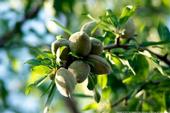
California produces more than 80 percent of the world's commercial almonds. Popularity of the nuts has spurred almond acreage in the state to expand from 510,000 acres in 2000 to roughly 890,000 acres in 2015, according to the USDA National Agricultural Statistics Service. California's Global Warming Solutions Act of 2006, which requires statewide reductions in greenhouse gas emissions, as well as the growing interest among consumers and food companies in the carbon footprint of food products, prompted some University of California scientists to examine how almond production affects the...
- Author: Jeannette E. Warnert
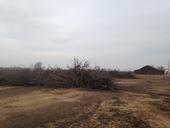
When almond orchards are about 25 years old, farmers must pull out the trees and plant new ones to maintain quality and yield. Typically, the old trees are pushed out and burned or ground up and hauled to a co-generation plant. However, UC Cooperative Extension advisor Brent Holtz believes there may be a better way.
Holtz has been pioneer in ag burn alternatives throughout his 26-year-career with UCCE, and going back still further on his family almond farm near Modesto. Beginning in the early 1990s, Holtz and his father experimented with chipping almond prunings instead of burning them, long before air quality regulations required wide implementation of the practice.
When...
- Author: Jeannette E. Warnert
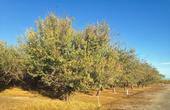
The dragon sleeping underneath Central Valley almond orchards is yawning and stretching its legs. The dragon is salinity, says UC Cooperative Extension farm advisor David Doll. “You don't notice it until it's too late, and that's when we have a problem,” he said.
Saline accumulation in the orchard soil profile is a recurring headache. But it becomes more acute during droughts, when farmers use more groundwater – which is generally more saline than surface water – or their surface water supply is more saline than normal.
Salinity accumulates in the soil when the tree is growing quickly and almonds are developing throughout spring and summer. When water...



